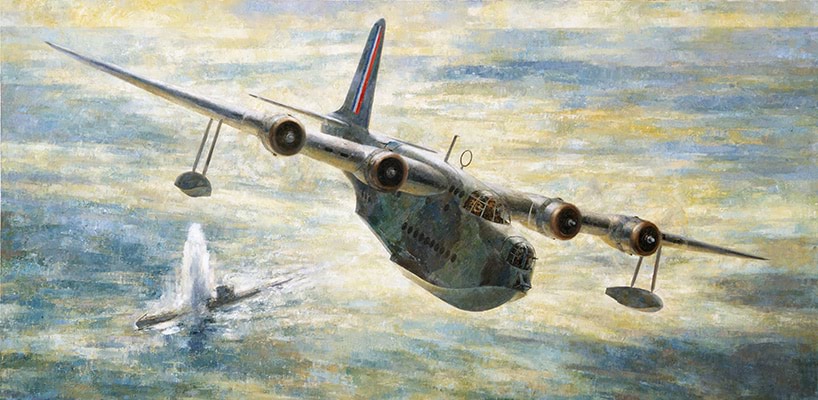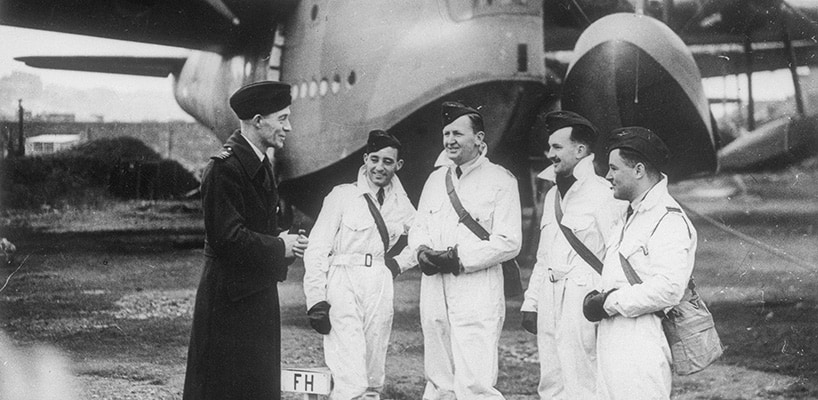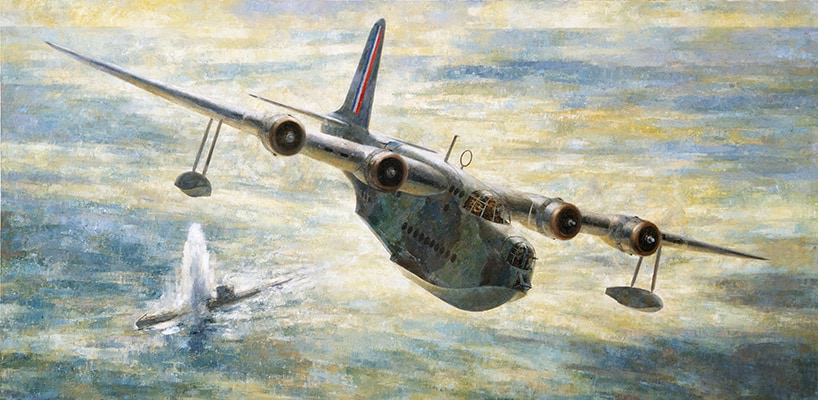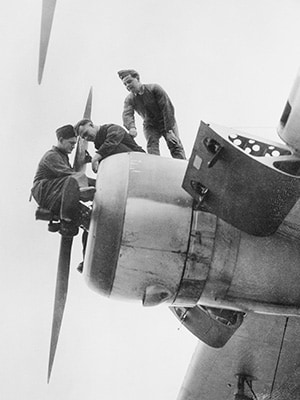
- Conflict:
- Second World War (1939-45)
- Service:
- Air Force
by Christopher Widenbar

No. 10 Squadron’s first commander, Leon Lachal, with the RAAF’s first DFC recipient Charles Pearce. L-R Wg Cdr Leon Lachal; Flt Lt W ‘Bill’ Gibson; Flt Lt Charles Pearce; F O Ivan Podger; Flt Lt W ‘Bill’ Garing.
Australian War Memorial (UK3073)
The year 1939 saw Australia’s armed forces rapidly re-arm to face the looming threats of both Nazi Germany and Imperial Japan. The Royal Australian Air Force (RAAF), the youngest, smallest and arguably the least ready of the three arms would, ironically, become the first to fight. Its standard bearers would be the airmen of No. 10 Squadron.
It was officially stood up at RAAF Point Cook, just outside Melbourne, on 1 July 1939. A maritime patrol squadron, No. 10 Squadron, was one of several new RAAF units formed that year. Because the United Kingdom was still Australia’s most important defence partner at this time, the British built Short Sunderland flying boat was selected to equip the squadron.
In July 1939 the first air and ground crews, under the command of Wing Commander Leon Lachal, arrived in the UK to undertake training on the new aircraft. Training was well underway when war broke out and the squadron was ordered to join Royal Air Force Coastal Command as Australia’s first contribution to the war against Germany.
10 Squadron became both the first Australian and Dominion force committed to action. It would be the only Australian unit to see continuous active service in the European theatre.
The Australian airmen, raised on newspaper articles about First World War ‘aces’ or the widely serialised ‘Biggles’ stories by Captain W E Johns, found themselves in a very different war. Instead of aerial duels over muddy lines of trenches, the crews of 10 Squadron found themselves conducting long, boring and often fruitless anti-submarine, maritime reconnaissance and meteorological patrols over the vast Atlantic.
However, the first combat casualties suffered by the unit—and indeed the RAAF—during the war occurred on a mission that would have done any First World War ‘Knight of the Sky’ proud: the attempted secret rescue of the family of Free French leader General Charles DeGaulle from Nazi occupied France.
10 Squadron’s Flight Lieutenant John Bell and Flight Sergeant Charles Harris, along with two British airmen, were sent to rescue the De Gaulle’s on the foggy night of 18 June 1940. Like all too many Coastal Command crews, which typically flew alone and far from friendly forces, they were never heard from again.
After the war, it was determined that the aircraft had crashed near Ploudaniel, France. While there remains conjecture about how the aircraft was lost, whatever the cause, Bell and Harris became the first members of the 10 Squadron killed in action. A further 151 Australians would follow them over the next five years.
Just over a month after the loss of Bell and Harris, 10 Squadron earned another, happier, RAAF record—the first ever RAAF Distinguished Flying Cross, awarded to Squadron Leader Charles Pearce. He was one of 10 Squadron’s early stars, captaining the first all-Australian crewed aerial patrol of the war and participating in several of the Squadron’s early successes against German submarines. His London Gazette citation reads:
This officer has consistently displayed gallantry and devotion to duty whilst engaged on convoy and antisubmarine patrols. In June 1940, Sqn Ldr Pearce attacked an enemy submarine off the coast of Portugal, one bomb being observed to burst by the bow. This officer has displayed courage and resource in antisubmarine work and, by his personal energy and skill, has formed the squadron into a highly efficient operational unit

by Dennis Adams oil on canvas
Illustration of a typical attack on a U-boat by a Sunderland flying boat of No. 10 Squadron, RAAF, in the Atlantic Ocean.
Australian War Memorial (ART27572)
The all-Australian nature of Pearce’s crew should also be noted. 10 Squadron was the only pre-war RAAF unit in Europe and as a result both aircrew and ground crew were almost exclusively Australian. The other RAAF units based in the UK were formed under Article XV; raised specifically for wartime service they were staffed by a mix of Australian, British, Canadian, New Zealand and other Dominion personnel.
This gave the squadron an uniquely Australian identity among RAAF units in the UK; it quickly gained distinction for its fighting spirit and Australian atmosphere. This was evident in the popularity of Australian Rules football and Two Up on base, and the sound of ‘Waltzing Matilda’ and other Australian songs on Mess Nights.
Pearce’s commendation also notes the most critical roles played by 10 Squadron early in the war - convoy and anti-submarine work. But flying boats like the Sunderland proved particularly useful in other roles too, including quickly transporting equipment or personnel to distant, infrastructure-starved destinations such as West Africa or on vital but risky air-sea rescues. 10 Squadron crews gained a reputation for being particularly willing to gamble their aircraft on the latter and conducted at least 117 successful rescues during the war, saving hundreds of sailors and airmen - both Allied and Axis.
10 Squadron records show they rarely saw the enemy on these missions, and some crews went their entire war without seeing a single enemy aircraft or submarine, but each flight was still potentially deadly. A mechanical failure over the Atlantic, hundreds of miles from help, or a navigational error, and a crew might never make it back to base. Bad weather was a major hazard, from fog to one of the Atlantic's legendary storms, which caused the loss of numerous Coastal Command crews, often without trace. Tired pilots flying at low altitude searching for men lost at sea had only the smallest margin of error to avoid crashing into the ocean.
Routine training missions could also turn deadly. Learning to land twenty tonnes of metal and fabric at 80 miles an hour on a rough sea on a moonless night was exactly as dangerous as it sounds. More than a third of Coastal Command’s wartime casualties occurred not in action against the enemy, but in training.
Life on base was less dangerous but still far from risk-free. Aircrew and ground crew alike risked their lives simply getting from shore to an aircraft; handling volatile munitions; or, as was often necessary, staying aboard moored aircraft during storms, carefully running the engines and trimming the rudder to maintain station and prevent the flying boats being dashed on the nearby rocky shores.
Even simply being in a country at war could be deadly. Flt Sgt ‘Ossie’ Ferguson for example, a popular 10 Squadron fitter, was killed whilst on sick leave in London by a German flying bomb. Ferguson had been awarded a British Empire Medal just days earlier for working, as his citation read ‘... night and day under very bad conditions, forgoing all privileges in order to meet a high standard of serviceability’.
The story of Coastal Command and 10 Squadron’s long war is one of the least known stories of the RAAF at war. Their contribution has perhaps been overshadowed by the drama of Spitfires over Darwin or the bloody and controversial campaigns of Bomber Command - not for nothing was Coastal Command known as the ‘Cinderella Service’ during the war.
Yet without these men and women - Women’s Auxiliary Air Force members also served in Coastal Command—it is highly likely that the ‘Battle of the Atlantic’ against the German U-boat menace would have been lost, and with it, the war.
Coastal Command losses totalled 10,875 between 1939 and 1945. This figure includes those killed on combat operations, in training and on the ground in enemy attacks and accidents alike. Among them were more than 400 Australians.
Unlike many Second World War units 10 Squadron is still flying today, it remains tasked with maritime patrol and proudly continues the traditions established over the Atlantic more than 70 years ago. The Shrine of Remembrance commemorates the service of No. 10 Squadron RAAF with a memorial plaque designed by and dedicated to its members on the Shrine Reserve and in the Second World War section of the Galleries of Remembrance.

Australian War Memorial (SUK14894)
The Sunderland was the largest aircraft in RAAF service for much of the war, with a wing span of more than 36 metres and weighing more than 20 tonnes fully loaded. To conduct its primary role of long-range maritime patrol it had a range of some 2,850km and an endurance of more than 20 hours on a single mission. Crewed by up to 11 men, it featured sleeping berths, a galley for cooking meals and the ultimate luxury - the first flushing porcelain toilet fitted to a combat aircraft. Perhaps the most surprising piece of equipment though was a pair of carrier pigeons that could be used to signal the location of the crew if their aircraft was forced down or their radio failed.
The Sunderland had an enviable reputation for endurance. This was due in part to sheer size and a heavy defensive armament but also clever design - Sunderlands were fitted with a small workshop and designed to allow access to critical components midflight. Even the engines could be repaired while the aircraft was in the air, although this required a very brave man to crawl into the wing itself in mid-air.
Leading Aircraftman Milton Griffin, a No. 10 Squadron flight engineer from Sydney, was awarded the Distinguished Flying Medal for doing exactly this not just once but repeatedly on 30 June 1941. Attacked by a German aircraft hundreds of miles from safety the Sunderland sustained extensive damage, with a leaking port wing oil tank and an overheating engine presenting a serious risk of fire - an almost certainly deadly outcome for all onboard. Griffin went into the wing no fewer than five times over the next few hours, repairing the engine and repeatedly patching and refilling the oil tank to allow the aircraft to limp home safely.
Author:
Christopher Widenbar is Manager Operations at the Shrine of Remembrance. Stumbling across his grandfather’s copy of Biggles of 266 with its tales of First World War aerial duels at a young age, sparked a lifelong interest in military aviation history. Formerly Museum Administrator/Curator of the RAAF Association Aviation Heritage Museum of WA, he will happily talk about the virtues and vices of any First or Second World War aircraft given half the chance.
Updated